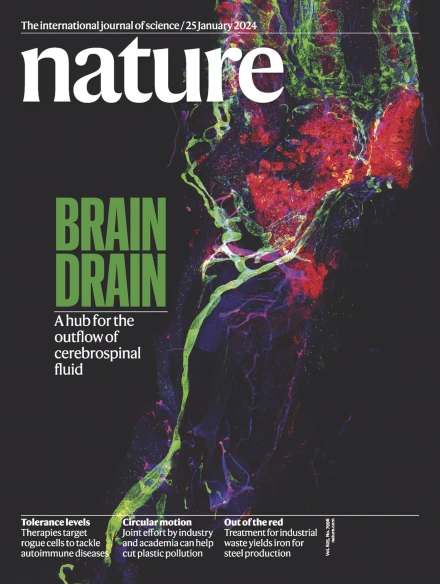欧洲核子研究中心反物质工厂的质子输运
IF 48.5
1区 综合性期刊
Q1 MULTIDISCIPLINARY SCIENCES
引用次数: 0
摘要
CERN1的反物质工厂(AMF)专门使用低能反质子进行精确测量,提供了对电荷-奇偶-时间(CPT)不变性的严格测试,这是粒子物理标准模型中的基本对称性。例如,这些测试已经在反质子氦3和反氢4中实现。在我们的低温潘宁阱实验中,我们测量了质子和反质子的磁矩和电荷质量比,现在提供了重子区CPT不变性的最精确测试。我们的实验受到AMF中减速机施加的磁场波动的限制;因此,我们正在推进将反质子重新安置到专门的精密实验室。在这里,我们展示了利用base - step9从AMF成功传输被捕获的质子云,这是一个可传输的、超导的、自主的和开放的pennning -trap系统,可以将反质子分配到其他实验中。我们将捕获的质子从AMF实验区转移到卡车上,穿过CERN的Meyrin站点,展示了在没有外部电源的情况下自主运行4小时,并且质子无丢失重新定位。因此,我们确认了将颗粒转移到AMF附近的低噪音实验室以及使用卡车上的发电机10到达欧洲各地实验室的可行性。这标志着精确反物质研究的新时代的潜在开始,使反质子、带电反物质离子\({\bar{{\rm{H}}}}^{+}\) 11和\({\bar{{\rm{H}}}}_{2}^{-}\)(参考文献12)以及其他加速器产生的离子(如类氢铅或铀离子13,14)的低噪声测量成为可能。本文章由计算机程序翻译,如有差异,请以英文原文为准。


Proton transport from the antimatter factory of CERN
Precision measurements using low-energy antiprotons, exclusively available at the antimatter factory (AMF) of CERN1, offer stringent tests of charge–parity–time (CPT) invariance, which is a fundamental symmetry in the Standard Model of particle physics2. These tests have been realized, for example, in antiprotonic helium3 and antihydrogen4. In our cryogenic Penning-trap experiments5, we measure the magnetic moments6,7 and charge-to-mass ratios of protons and antiprotons and now provide the most precise test of CPT invariance in the baryon sector8. Our experiments are limited by magnetic field fluctuations imposed by the decelerators in the AMF; therefore, we are advancing the relocation of antiprotons to dedicated precision laboratories. Here we present the successful transport of a trapped proton cloud from the AMF using BASE-STEP9—a transportable, superconducting, autonomous and open Penning-trap system that can distribute antiprotons into other experiments. We transferred the trapped protons from our experimental area at the AMF onto a truck and transported them across the Meyrin site of CERN, demonstrating autonomous operation without external power for 4 h and loss-free proton relocation. We thereby confirm the feasibility of transferring particles into low-noise laboratories in the vicinity of the AMF and of using a power generator on the truck10 to reach laboratories throughout Europe. This marks the potential start of a new era in precision antimatter research, enabling low-noise measurements of antiprotons, the charged antimatter ions $${\bar{{\rm{H}}}}^{+}$$ 11 and $${\bar{{\rm{H}}}}_{2}^{-}$$ (ref. 12), and other accelerator-produced ions, such as hydrogen-like lead or uranium ions13,14. The successful transport of a trapped proton cloud from the antimatter factory of CERN using a transportable, superconducting, autonomous and open Penning-trap system that can distribute antiprotons into other experiments is reported.
求助全文
通过发布文献求助,成功后即可免费获取论文全文。
去求助
来源期刊

Nature
综合性期刊-综合性期刊
CiteScore
90.00
自引率
1.20%
发文量
3652
审稿时长
3 months
期刊介绍:
Nature is a prestigious international journal that publishes peer-reviewed research in various scientific and technological fields. The selection of articles is based on criteria such as originality, importance, interdisciplinary relevance, timeliness, accessibility, elegance, and surprising conclusions. In addition to showcasing significant scientific advances, Nature delivers rapid, authoritative, insightful news, and interpretation of current and upcoming trends impacting science, scientists, and the broader public. The journal serves a dual purpose: firstly, to promptly share noteworthy scientific advances and foster discussions among scientists, and secondly, to ensure the swift dissemination of scientific results globally, emphasizing their significance for knowledge, culture, and daily life.
 求助内容:
求助内容: 应助结果提醒方式:
应助结果提醒方式:


